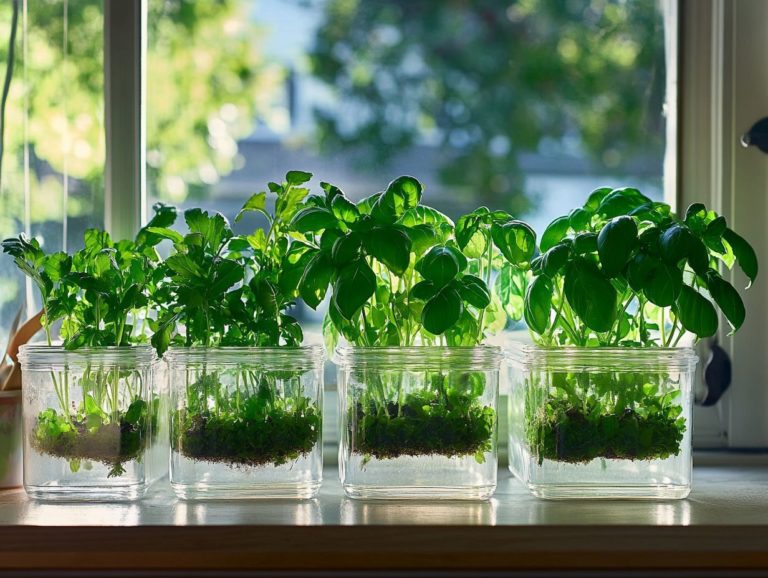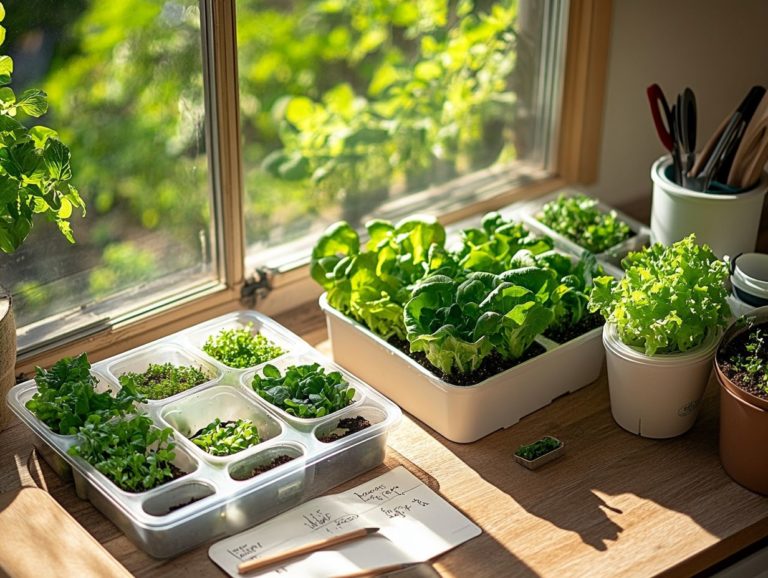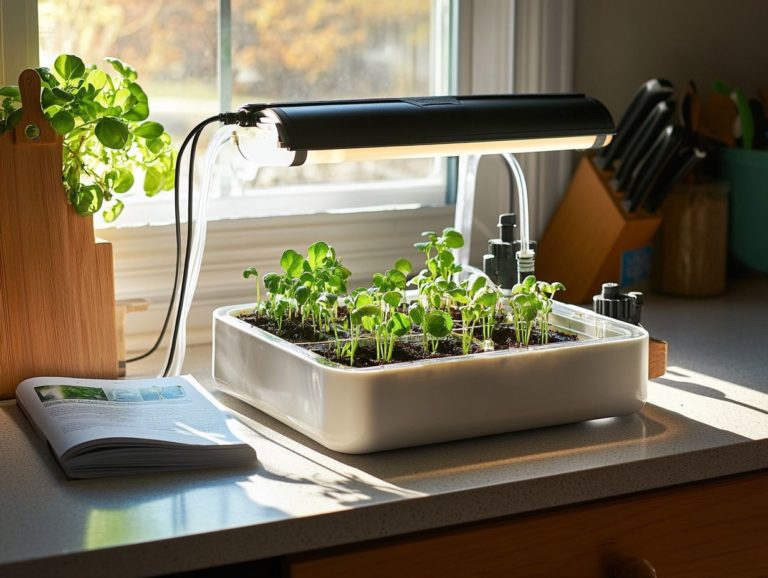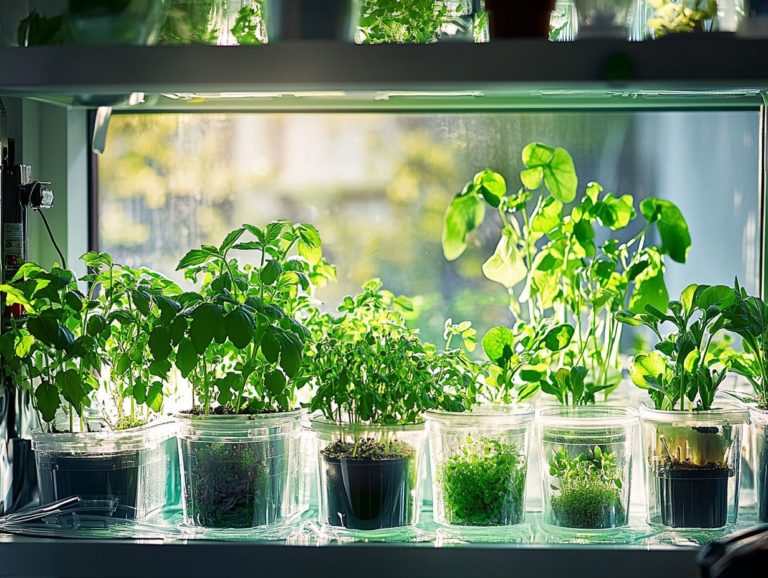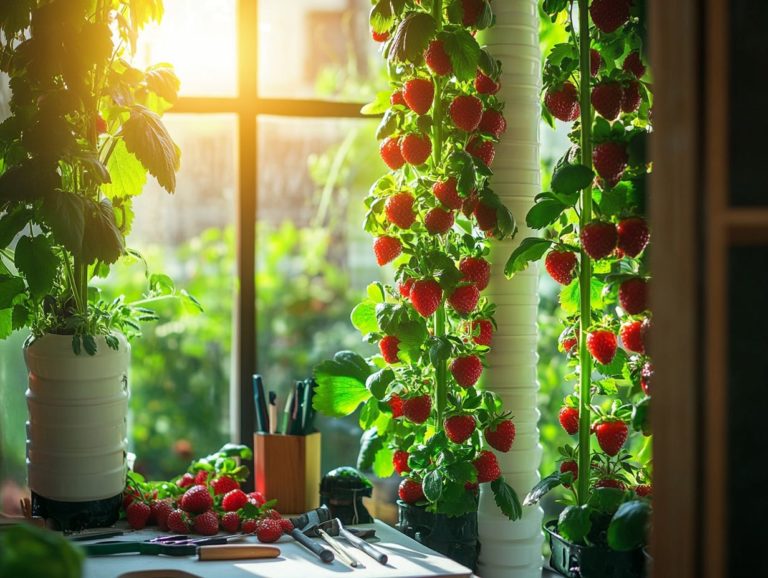5 Best Hydroponic Systems for Beginners
Curious about growing plants without soil? Hydroponics could be just the solution you ve been seeking.
This innovative gardening method offers numerous benefits, including faster growth rates and more efficient use of space and water.
You ll discover five hydroponic systems that are ideal for beginners, such as Deep Water Culture (DWC) and Ebb and Flow setups.
You’ll also find essential tips on selecting the right system, common pitfalls to avoid, and everything you need to embark on your hydroponic journey.
Are you ready to dive in and grow?
Contents
- Key Takeaways:
- 1. Deep Water Culture (DWC) System
- 2. Ebb and Flow System
- 3. Drip System
- 4. Nutrient Film Technique (NFT) System
- 5. Wick System
- What Is Hydroponics and How Does It Work?
- How Can a Beginner Set Up a Hydroponic System?
- What Are the Common Mistakes to Avoid When Using a Hydroponic System?
- Frequently Asked Questions
- Looking for the best hydroponic systems as a beginner? Here are the top 5!
- What is Deep Water Culture (DWC) and why is it a good choice for beginners?
- How does the Ebb and Flow system work?
- What are the advantages of using a Drip System?
- Can I make my own Wick System at home?
- What is the Nutrient Film Technique (NFT) and why is it recommended for beginners?
Key Takeaways:

- DWC is beginner-friendly, requiring low maintenance while offering a compact footprint.
- Ebb and Flow provides flexibility for various plant types but may need more equipment and space.
- The Drip system is suited for larger setups, offering precise nutrient control but can be complex and costly for beginners.
1. Deep Water Culture (DWC) System
The Deep Water Culture (DWC) system stands out as one of the most efficient hydroponic setups for indoor gardening. It allows you to cultivate plants in water enriched with plant food, ensuring optimal growth while keeping the roots submerged in oxygenated water for maximum nutrient absorption.
This user-friendly method is especially appealing for beginners, offering the potential for high-quality vegetables and herbs in a compact space.
By eliminating soil, you’ll significantly reduce the risk of pest infestations and diseases, creating a cleaner, more enjoyable gardening experience. The DWC setup accelerates growth rates, as plants can directly access nutrients through their roots.
For your DWC system, consider these ideal choices for plants:
- Leafy greens like lettuce, basil, and cilantro
- Herbs such as mint
- Fruiting plants like tomatoes and peppers
These plants thrive in DWC conditions. Popular options like the AeroGarden Bounty, Moistenland Indoor Garden, and Gardyn Home Kit 2.0 use DWC methods, making it easier for you to enjoy the benefits of hydroponics with minimal setup and maintenance. To explore more about the latest advancements, check out 5 innovative hydroponic growing technologies.
2. Ebb and Flow System
The Ebb and Flow system, often called flood and drain, is a popular hydroponic technique that periodically inundates the grow bed with nutrient-rich water before draining it back to a reservoir. This dynamic water circulation not only supplies essential nutrients but also helps prevent root rot.
This innovative approach is particularly beneficial for cultivating a variety of plants, including vibrant tomatoes and crisp leafy greens. By allowing roots to breathe between watering cycles, it supports robust root development and enhances overall plant health.
Key components of this system include a pump, a timer, and a grow bed, all designed to optimize nutrient delivery and drainage.
Compared to other hydroponic systems, like nutrient film technique or deep water culture, the Ebb and Flow system provides superior flexibility and control. This makes it an excellent choice for indoor gardening enthusiasts aiming to maximize growth potential while conserving space and resources.
Start your hydroponic adventure today!
3. Drip System
The Drip System is an effective and versatile hydroponic setup that delivers nutrient-rich plant food directly to your plants’ roots through a sophisticated network of tubes and emitters. This makes it a great choice for various indoor gardening configurations.
With this method, you save water while promoting robust growth by providing each plant with the right amount of moisture. As the nutrient solution drips, it reaches the root zone consistently, enhancing nutrient absorption and preventing over-saturation, which could lead to root rot.
This system works well with different plants, especially leafy greens and herbs, which thrive on the steady supply of nutrients. Compared to other hydroponic techniques, like nutrient film technique or deep water culture, the Drip System often stands out as the more user-friendly and flexible option. For those looking to optimize their gardening setup, consider choosing the right hydroponic system for your space, perfect for both seasoned gardeners and beginners.
4. Nutrient Film Technique (NFT) System
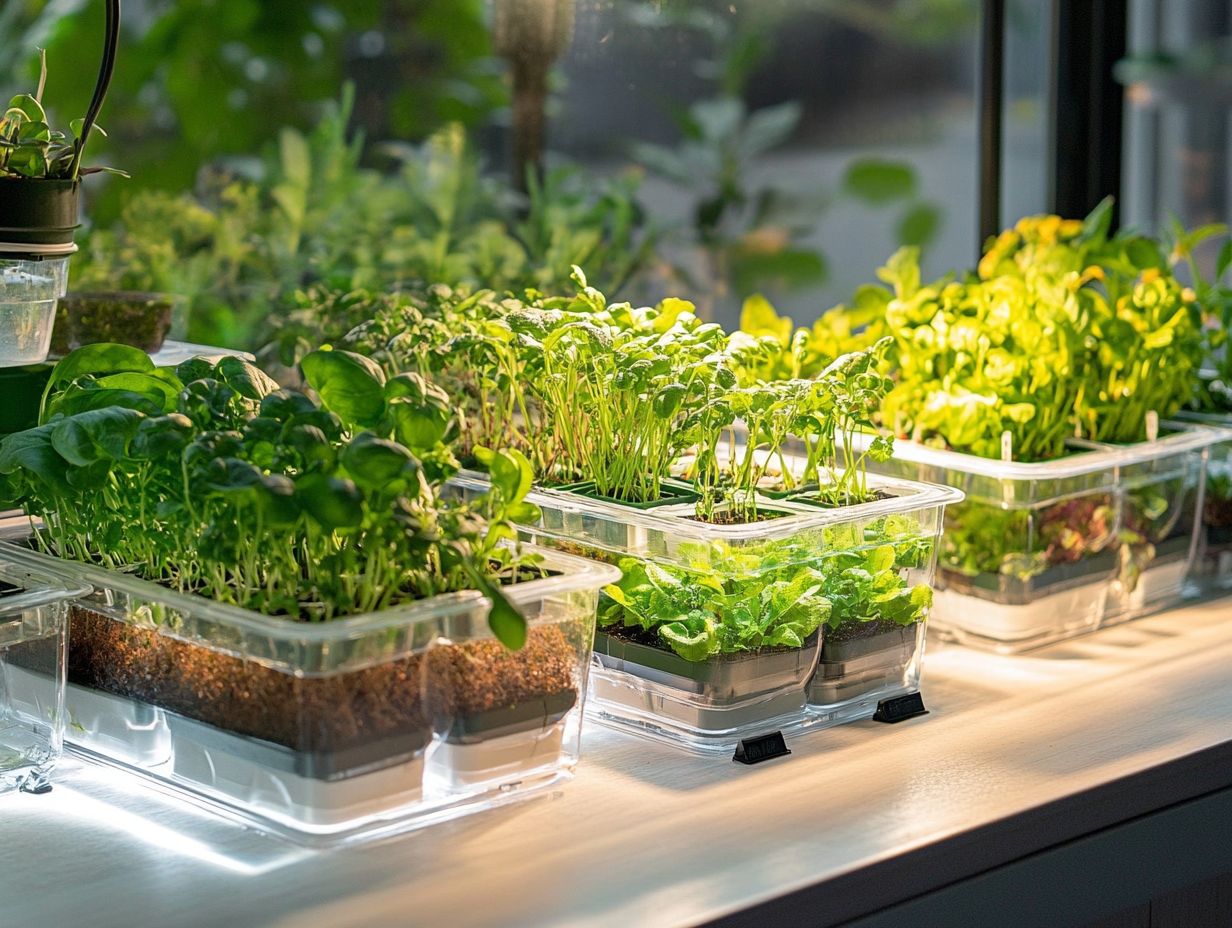
The Nutrient Film Technique (NFT) system is a new hydroponic method that allows a thin film of nutrient-rich water to flow over your plants’ roots. This approach ensures they have constant access to essential nutrients while facilitating optimal oxygen exchange, making it a prime choice for anyone passionate about indoor gardening.
With this innovative technique, you’ll save water and enhance plant growth efficiency. The recirculating principle helps reduce waste, setting NFT apart from traditional gardening, which typically requires larger volumes of water. You conserve resources while promoting faster growth rates.
Ideal for growing herbs and leafy greens like lettuce, basil, and spinach, this system not only boosts flavor profiles but also enables year-round cultivation no seasonal limits. For many gardeners, the NFT system is a compelling option worth exploring for a sustainable gardening experience.
5. Wick System
The Wick System is a straightforward and user-friendly hydroponic solution that uses capillary action the way water travels through small spaces to deliver nutrient-rich water to your plants’ roots. This makes it a great option for beginners, allowing for easy cultivation of various herbs and vegetables.
This setup reduces the need for complicated equipment and optimizes water efficiency, enabling plants like basil, lettuce, and mint to thrive with minimal effort. Unlike traditional gardening, the Wick System eliminates the risk of overwatering; its wick mechanism ensures a steady moisture supply without the threat of waterlogging.
While this system offers unmatched convenience, it has its limitations. It may be less effective for larger plants needing extensive root systems and higher nutrient intake. Some flowering plants might not thrive as well as those in soil-based setups, so experimenting with various plant types is encouraged to find your perfect match. For those new to this method, consider checking out a beginner’s guide to hydroponic systems for helpful insights.
What Is Hydroponics and How Does It Work?
Hydroponics provides a new approach to growing plants without soil. With nutrients delivered directly to the roots through a water-based solution, you optimize nutrient uptake and accelerate growth, making it a top choice for indoor gardening fans eager to maximize yields in limited spaces.
Unlike traditional gardening, which relies on soil to supply nutrients and retain moisture, hydroponics allows for a controlled environment that leads to quicker harvests and healthier plants. You’ll find various hydroponic systems for home gardeners designed for different needs and space constraints, including:
- Nutrient film technique (NFT)
- Deep water culture (DWC)
- Aeroponics
Among user-friendly options, the AeroGarden Bounty stands out with its compact size, enabling you to easily grow fresh herbs and vegetables at home. These systems support robust plant growth in a water culture, showcasing the effectiveness of hydroponic techniques. For more insights, check out the top 5 hydroponic growing systems for beginners.
What Are the Benefits of Using a Hydroponic System?
Utilizing a hydroponic system presents a multitude of advantages, including accelerated growth rates, reduced water usage, and the remarkable ability to cultivate a variety of plants indoors regardless of external weather conditions. This makes it an enticing option for both novice gardeners and seasoned horticulturists.
These systems conserve valuable space, allowing for vertical gardening solutions that fit into compact areas. They also enable year-round crop production. By optimizing conditions like light, temperature, and nutrient delivery, understanding the basics of hydroponic systems creates an ideal environment for nurturing vegetables, aromatic herbs, and nutrient-dense organic microgreens.
They typically attract fewer pests and diseases compared to traditional soil gardening, significantly reducing the need for pesticides and fostering healthier plants. This approach benefits your gardening experience and contributes positively to the environment, creating a sustainable method that supports both the grower and the ecosystem.
What Are the Key Factors to Consider When Choosing a Hydroponic System?
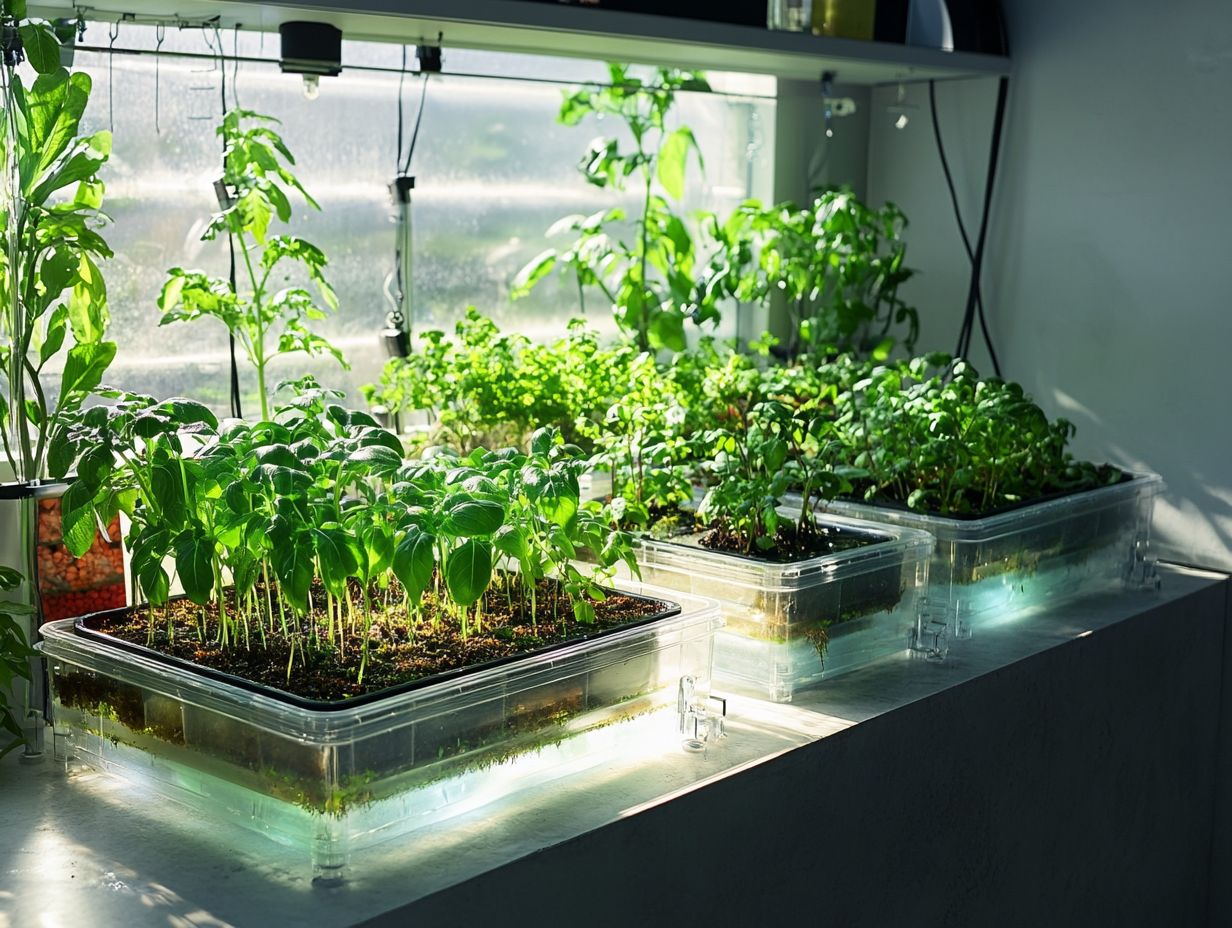
Selecting the right hydroponic system requires evaluating several key factors: the space you have available, the types of plants you want to cultivate, the system’s ease of use, and the setup and maintenance demands. Each of these elements is essential for ensuring a thriving indoor gardening experience.
Don’t forget to consider your budget as well, since prices can vary significantly among consumer models like the AeroGarden Harvest and Lettuce Grow Farmstand. By thoughtfully assessing these factors, you’ll be well-equipped to choose a hydroponic system that aligns with your gardening goals and lifestyle preferences. Understanding the 5 essential components of a hydroponic system can also help in making an informed decision.
What Are the Different Types of Hydroponic Systems?
- Deep Water Culture: Ideal for leafy greens and herbs.
- Ebb and Flow: Offers flexibility for various plants, including fruiting crops.
- Drip Systems: Highly water-efficient, suitable for small and large setups.
- Nutrient Film Technique: Promotes quicker growth cycles, great for commercial setups.
- Wick Systems: Excellent for beginners, especially with herbs and small vegetables.
These systems are designed to meet diverse gardening objectives, whether you re looking to maximize yield or conserve space. Regardless of your level of gardening expertise, there’s a hydroponic method that perfectly suits your journey.
How Can a Beginner Set Up a Hydroponic System?
Setting up a hydroponic system as a beginner is an exhilarating journey! You can achieve it with just a few straightforward steps. Start by selecting the right system for your needs, like the AeroGarden Bounty or the Moistenland Indoor Garden. Then, gather your essential materials to create the perfect environment for your plants.
Next, dive into researching nutrient solutions tailored for the plants you want to grow. These solutions provide the essential elements that foster healthy growth. Don t forget to invest in adequate lighting. LED grow lights use less energy and last longer than traditional lights!
Choosing the right plants is another crucial step. Think about starting with herbs or leafy greens, as they thrive in hydroponic setups and offer bountiful rewards. With these preparations in place, you re about to embark on an amazing gardening adventure!
What Are the Common Mistakes to Avoid When Using a Hydroponic System?
Common mistakes in hydroponic gardening include:
- Over- or under-watering
- Neglecting pH balance
- Mismanaging nutrient levels
These missteps can significantly affect your plants’ health and yield. Be aware of these pitfalls for successful indoor gardening!
Many novice gardeners often misjudge how frequently and how much water their plants truly need. Monitor moisture levels regularly and adjust your watering schedule accordingly.
The pH balance, which is the level of acidity or alkalinity in the water, is another critical factor to pay attention to. A pH that s too high or too low can impede nutrient absorption. Investing in a reliable pH testing kit can help you keep tabs on this important aspect. Understanding the specific nutrient requirements of your various plants will also help you avoid imbalances.
By adhering to systematic fertilization schedules and observing your plants’ growth stages, you can ensure that nutrient levels remain optimal for vigorous growth.
Frequently Asked Questions
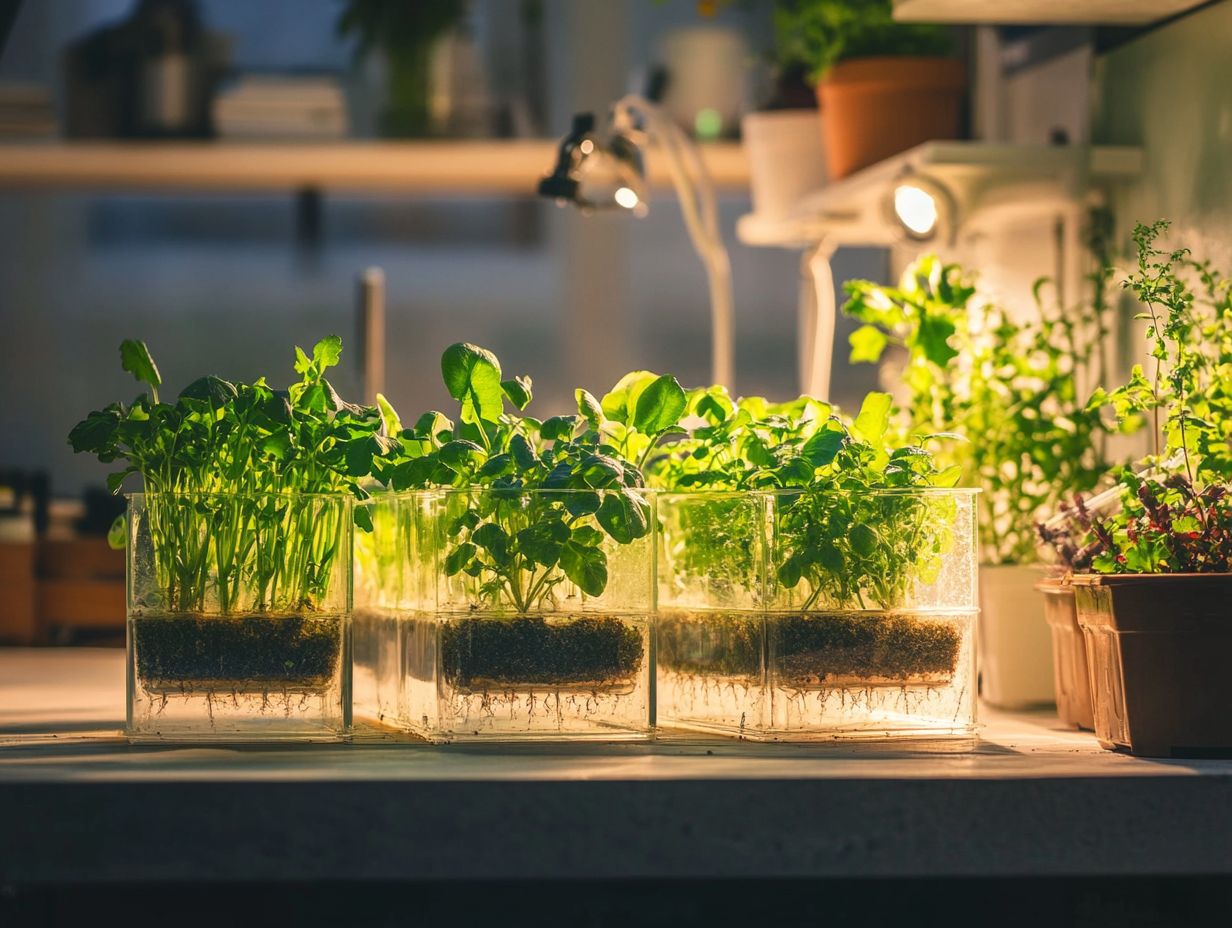
Looking for the best hydroponic systems as a beginner? Here are the top 5!
- Deep Water Culture (DWC)
- Ebb and Flow
- Drip System
- Wick System
- Nutrient Film Technique (NFT)
What is Deep Water Culture (DWC) and why is it a good choice for beginners?
Deep Water Culture (DWC) is a hydroponic system where plants are suspended above a reservoir of water and nutrients. It is a good choice for beginners because it is simple to set up and requires minimal maintenance.
How does the Ebb and Flow system work?
The Ebb and Flow system uses a timer to flood the plant’s root zone with nutrient solution and then drains it back into a reservoir. This cycle is repeated multiple times a day, providing the plants with water and nutrients.
What are the advantages of using a Drip System?
A Drip System delivers nutrient solution to the plants through small tubes. The advantages of using this system include consistent watering and nutrient delivery, as well as the ability to automate the process.
Can I make my own Wick System at home?
Yes! The Wick System is a simple, low-cost hydroponic system that can be made at home. All you need is a container, wick material, and a nutrient solution. It s a great option for beginners on a budget.
What is the Nutrient Film Technique (NFT) and why is it recommended for beginners?
The Nutrient Film Technique (NFT) is a hydroponic system where a thin film of nutrient solution continuously flows over the plant’s roots. It is recommended for beginners because it is low-maintenance and provides consistent watering and nutrient delivery.
Start your hydroponic journey today and watch your plants thrive!

